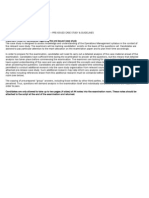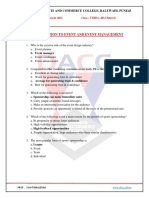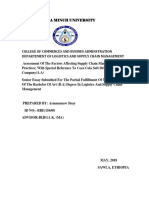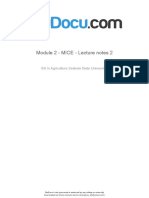Operations Management Notes Lecture 1
Uploaded by
Shirley Soriano-QuintoOperations Management Notes Lecture 1
Uploaded by
Shirley Soriano-QuintolOMoARcPSD|9484490
Operations Management Notes - Lecture 1
Introduction to Operations Management (Trinity College Dublin University of Dublin)
StuDocu is not sponsored or endorsed by any college or university
Downloaded by Shirley Soriano-Quinto (shengjhay_23@yahoo.com)
lOMoARcPSD|9484490
Operations Management (Lecture 1)
Add real life examples to exam answers & assigments
UNITO – book available to download ‘Lean Service’
Two MCQ’s = 10%
One hour MCQ’s = 50%
2,000 word essay = 40% (due date 31st Jan)
Business is simple
o Give the customer what they want – product of service
o When they want is
o At a price they are prepared to pay – market set price, even in non-profit
o Make a profit - repeatedly, again and again
Business are Complex
o Made up of many parts, marketing, accounting, sales, manufactoring, admin,
human resources, etc
Four Perspecives
o Market Requirements – quality, speed, flexibiltiy, cost
o Operations Reseources – meet demand of market with what we have, not too
much not too few resources
o Bottom up – can we build resoruces of the organisation to crwate new
capabilites, challenge people to make company better
o Top down – traitonal, strategic way, focuses, competitivness
Balancing act, all 4 must be around a pivot
Dynamic balance, always moving
Due to customers and competitors
Operating Model
o Business Strategy
o Functional Strategy
Reserouces
o Equiptment
o Premises
o Money
o People
o Systems
Downloaded by Shirley Soriano-Quinto (shengjhay_23@yahoo.com)
lOMoARcPSD|9484490
The work is at the core
o What is being done – core product, focusing on fact and real data
o How – deliver value of said product
o Why –
How to get things done
o Processes – manufacturing vs services
o hard of soft to see?
What are the most important people to a business?
o Leaders – decision making
o Supervisor, vs shop floor, leaders at all levels, breaking the norm
Senior Officers Expertise “C-Suite”
o Technical Expertise –
o Leadership Expertise -
o Process Expertise –
All of them overlap to give functional ‘operations management’
Chickens and pigs
o Values – who we are
o Vision – what we wanna be
o Mission – what we are going to achievce
o Objectoves – what we are going to do
o Operations and manufacturing – our part of the process
Lean Service
o Creating and devopling the capabilities of people and processes – potential, max
outcome
o Diagnosis – capturing of sitatuions, issues constantly changing & moving
forward
o Medicine- proven tools, work with and for small or medium companises, basied
on building peoples capactiy and capabilites, simple and powerful, right tools at
the right time
o Benchmarking – provides an objective view of your business, identifies issues
and areas needing attention, helps prioritize areas for imporvement
o Simple approach, small and medium sized businesses
o Appropriate tools at each stage of development
o A journey to improvement – operations is not static
o Ferdow and de Meyers
o JIT – just in time
o TQM – total quality managemet
Downloaded by Shirley Soriano-Quinto (shengjhay_23@yahoo.com)
lOMoARcPSD|9484490
o AFR – absolutely focused and relentless
o BPR –
Startegic planning
o What are we going to do – how to move forward
o Plan needed to be able to deliver growth and profitability
o After its done, internal and external analysis required
o Industrial commons – commonn grazing land, all shared, well mantained,
nicreases opperturniyy to prosper
o Creating , developing, sustaining
o SWOT anaylsis, strenghts, weaknesses, oppertunities, threats
o Developing mission and objectives
o Defining strategies
o Implementing with aciton plans
o
Downloaded by Shirley Soriano-Quinto (shengjhay_23@yahoo.com)
You might also like
- Week 4 - Module 4.2 Creative Problem SolvingNo ratings yetWeek 4 - Module 4.2 Creative Problem Solving22 pages
- Faith and Power in Japanese Buddhist Art (Art Ebook)100% (1)Faith and Power in Japanese Buddhist Art (Art Ebook)401 pages
- Critical Review of The Theories of Competitive Advantage and Evaluate Their Relevance To ManagementNo ratings yetCritical Review of The Theories of Competitive Advantage and Evaluate Their Relevance To Management15 pages
- Hutt - Business Marketing Management-B2B 11e100% (1)Hutt - Business Marketing Management-B2B 11e18 pages
- English Level Test Upper-Intermediate B2No ratings yetEnglish Level Test Upper-Intermediate B24 pages
- Chapter 1 - ST - Introduction To Procurement ManagementNo ratings yetChapter 1 - ST - Introduction To Procurement Management17 pages
- Business Policy and Strategic Management PDF100% (1)Business Policy and Strategic Management PDF23 pages
- Ema Uk He Slack Opsman 4 Student Resources Chapter 3 Operations Strategy Multiple-Choice QuestionsNo ratings yetEma Uk He Slack Opsman 4 Student Resources Chapter 3 Operations Strategy Multiple-Choice Questions2 pages
- Operations Management Handout-OM MBA Infolink College dt-2022-02-08 10-24-580% (1)Operations Management Handout-OM MBA Infolink College dt-2022-02-08 10-24-58261 pages
- Instant Download (eBook PDF) Foundations of Operations Management 4th Canadian Edition PDF All Chapters100% (7)Instant Download (eBook PDF) Foundations of Operations Management 4th Canadian Edition PDF All Chapters46 pages
- Andrew - Lambert@kcl - Ac.uk: Department of War Studies, King's College LondonNo ratings yetAndrew - Lambert@kcl - Ac.uk: Department of War Studies, King's College London11 pages
- Evaluating Opportunities in The Changing Market EnvironmentNo ratings yetEvaluating Opportunities in The Changing Market Environment38 pages
- MGMT 4441 Management Thought and Emerging TrendsNo ratings yetMGMT 4441 Management Thought and Emerging Trends135 pages
- Test Bank For Organizational Behavior 1st Edition by Neubert100% (1)Test Bank For Organizational Behavior 1st Edition by Neubert20 pages
- Performance-Appraisal-Training-And-Development-Human-Resource-Management (Set 1)No ratings yetPerformance-Appraisal-Training-And-Development-Human-Resource-Management (Set 1)8 pages
- Unit 1. Introduction To Event and Event Management: Dnyansagar Arts and Commerce College, Balewadi, Pune45No ratings yetUnit 1. Introduction To Event and Event Management: Dnyansagar Arts and Commerce College, Balewadi, Pune4535 pages
- Management Information Systems-0109 PDFNo ratings yetManagement Information Systems-0109 PDF13 pages
- Chapter 1 Marketing: Creating and Capturing Customer ValueNo ratings yetChapter 1 Marketing: Creating and Capturing Customer Value7 pages
- Chapter Two External Enviromental ScanningNo ratings yetChapter Two External Enviromental Scanning32 pages
- Chapter One: The Nature of Strategic Management100% (1)Chapter One: The Nature of Strategic Management34 pages
- Assignment - MBA-302 Operations ManagementNo ratings yetAssignment - MBA-302 Operations Management3 pages
- Strategic Management MCQ Questions and Solutions With Explanations - Management Page-12 Section-1No ratings yetStrategic Management MCQ Questions and Solutions With Explanations - Management Page-12 Section-14 pages
- Chapter 6 - International Logistics, Risks InsuranceNo ratings yetChapter 6 - International Logistics, Risks Insurance41 pages
- Business Management Multiple Choice QuesNo ratings yetBusiness Management Multiple Choice Ques15 pages
- Chapter # 1: Foundations of Information Systems in BusinessNo ratings yetChapter # 1: Foundations of Information Systems in Business25 pages
- The Benefit Cost of VDT Highlighting PDFNo ratings yetThe Benefit Cost of VDT Highlighting PDF9 pages
- Chapter 1 – Foundations, Professionalism, TrendsNo ratings yetChapter 1 – Foundations, Professionalism, Trends3 pages
- Operations Management Essay Operations Management EssayNo ratings yetOperations Management Essay Operations Management Essay4 pages
- Bachelor of Science in Hospitality Management BSHMNo ratings yetBachelor of Science in Hospitality Management BSHM5 pages
- Macasandig/Pueblo, Cagayan de Oro City: Senior High School - Empowerment Technology Learning PlanNo ratings yetMacasandig/Pueblo, Cagayan de Oro City: Senior High School - Empowerment Technology Learning Plan2 pages
- REET Vigyapti 2021 3rd Grade Teacher Bharti Apply Online FormNo ratings yetREET Vigyapti 2021 3rd Grade Teacher Bharti Apply Online Form2 pages
- Learning Competency: Maintenance of Finished Work Intellectual Property Rights (IPR)No ratings yetLearning Competency: Maintenance of Finished Work Intellectual Property Rights (IPR)6 pages
- (Prepflix) Wipro NLTH Top 30 HR Round Qns & AnsNo ratings yet(Prepflix) Wipro NLTH Top 30 HR Round Qns & Ans8 pages
- PARAS - Magna Carta For Women, Anti-Sexual Harrassment & MinorsNo ratings yetPARAS - Magna Carta For Women, Anti-Sexual Harrassment & Minors54 pages
- Jharkhand Govt Gazette Regarding Stipend For LawyersNo ratings yetJharkhand Govt Gazette Regarding Stipend For Lawyers6 pages
- 08.0 PP 23 32 Prologue Yudhoyonos Legacy An Insiders ViewNo ratings yet08.0 PP 23 32 Prologue Yudhoyonos Legacy An Insiders View10 pages
- BIZ 1054 Progressive English: Institut Pendidikan GuruNo ratings yetBIZ 1054 Progressive English: Institut Pendidikan Guru9 pages
- PWC Aviation Mro Supply Chain Benchmarking StudyNo ratings yetPWC Aviation Mro Supply Chain Benchmarking Study8 pages
- Final Assignment - Business Strategy - Blemba 62 - Syindicate 4 PDFNo ratings yetFinal Assignment - Business Strategy - Blemba 62 - Syindicate 4 PDF18 pages
- Final Year Thesis Project: Culinary Training InstituteNo ratings yetFinal Year Thesis Project: Culinary Training Institute47 pages
- Faith and Power in Japanese Buddhist Art (Art Ebook)Faith and Power in Japanese Buddhist Art (Art Ebook)
- Critical Review of The Theories of Competitive Advantage and Evaluate Their Relevance To ManagementCritical Review of The Theories of Competitive Advantage and Evaluate Their Relevance To Management
- Chapter 1 - ST - Introduction To Procurement ManagementChapter 1 - ST - Introduction To Procurement Management
- Ema Uk He Slack Opsman 4 Student Resources Chapter 3 Operations Strategy Multiple-Choice QuestionsEma Uk He Slack Opsman 4 Student Resources Chapter 3 Operations Strategy Multiple-Choice Questions
- Operations Management Handout-OM MBA Infolink College dt-2022-02-08 10-24-58Operations Management Handout-OM MBA Infolink College dt-2022-02-08 10-24-58
- Instant Download (eBook PDF) Foundations of Operations Management 4th Canadian Edition PDF All ChaptersInstant Download (eBook PDF) Foundations of Operations Management 4th Canadian Edition PDF All Chapters
- Andrew - Lambert@kcl - Ac.uk: Department of War Studies, King's College LondonAndrew - Lambert@kcl - Ac.uk: Department of War Studies, King's College London
- Evaluating Opportunities in The Changing Market EnvironmentEvaluating Opportunities in The Changing Market Environment
- Test Bank For Organizational Behavior 1st Edition by NeubertTest Bank For Organizational Behavior 1st Edition by Neubert
- Performance-Appraisal-Training-And-Development-Human-Resource-Management (Set 1)Performance-Appraisal-Training-And-Development-Human-Resource-Management (Set 1)
- Unit 1. Introduction To Event and Event Management: Dnyansagar Arts and Commerce College, Balewadi, Pune45Unit 1. Introduction To Event and Event Management: Dnyansagar Arts and Commerce College, Balewadi, Pune45
- Chapter 1 Marketing: Creating and Capturing Customer ValueChapter 1 Marketing: Creating and Capturing Customer Value
- Strategic Management MCQ Questions and Solutions With Explanations - Management Page-12 Section-1Strategic Management MCQ Questions and Solutions With Explanations - Management Page-12 Section-1
- Chapter 6 - International Logistics, Risks InsuranceChapter 6 - International Logistics, Risks Insurance
- Chapter # 1: Foundations of Information Systems in BusinessChapter # 1: Foundations of Information Systems in Business
- Intellectual Capital Complete Self-Assessment GuideFrom EverandIntellectual Capital Complete Self-Assessment Guide
- Operations Management Essay Operations Management EssayOperations Management Essay Operations Management Essay
- Bachelor of Science in Hospitality Management BSHMBachelor of Science in Hospitality Management BSHM
- Macasandig/Pueblo, Cagayan de Oro City: Senior High School - Empowerment Technology Learning PlanMacasandig/Pueblo, Cagayan de Oro City: Senior High School - Empowerment Technology Learning Plan
- REET Vigyapti 2021 3rd Grade Teacher Bharti Apply Online FormREET Vigyapti 2021 3rd Grade Teacher Bharti Apply Online Form
- Learning Competency: Maintenance of Finished Work Intellectual Property Rights (IPR)Learning Competency: Maintenance of Finished Work Intellectual Property Rights (IPR)
- PARAS - Magna Carta For Women, Anti-Sexual Harrassment & MinorsPARAS - Magna Carta For Women, Anti-Sexual Harrassment & Minors
- Jharkhand Govt Gazette Regarding Stipend For LawyersJharkhand Govt Gazette Regarding Stipend For Lawyers
- 08.0 PP 23 32 Prologue Yudhoyonos Legacy An Insiders View08.0 PP 23 32 Prologue Yudhoyonos Legacy An Insiders View
- BIZ 1054 Progressive English: Institut Pendidikan GuruBIZ 1054 Progressive English: Institut Pendidikan Guru
- Final Assignment - Business Strategy - Blemba 62 - Syindicate 4 PDFFinal Assignment - Business Strategy - Blemba 62 - Syindicate 4 PDF
- Final Year Thesis Project: Culinary Training InstituteFinal Year Thesis Project: Culinary Training Institute
































































































